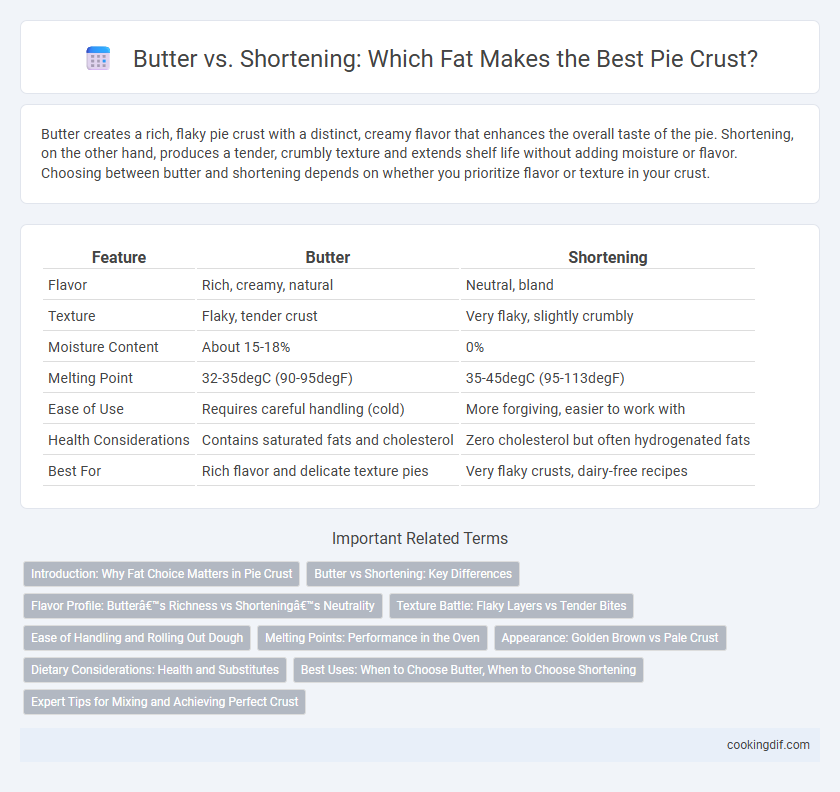Butter creates a rich, flaky pie crust with a distinct, creamy flavor that enhances the overall taste of the pie. Shortening, on the other hand, produces a tender, crumbly texture and extends shelf life without adding moisture or flavor. Choosing between butter and shortening depends on whether you prioritize flavor or texture in your crust.
Table of Comparison
| Feature | Butter | Shortening |
|---|---|---|
| Flavor | Rich, creamy, natural | Neutral, bland |
| Texture | Flaky, tender crust | Very flaky, slightly crumbly |
| Moisture Content | About 15-18% | 0% |
| Melting Point | 32-35degC (90-95degF) | 35-45degC (95-113degF) |
| Ease of Use | Requires careful handling (cold) | More forgiving, easier to work with |
| Health Considerations | Contains saturated fats and cholesterol | Zero cholesterol but often hydrogenated fats |
| Best For | Rich flavor and delicate texture pies | Very flaky crusts, dairy-free recipes |
Introduction: Why Fat Choice Matters in Pie Crust
Fat choice significantly impacts pie crust texture, flavor, and flakiness, with butter offering rich taste and natural browning while shortening provides superior tenderness and higher melting point for a flakier result. Butter's water content creates steam during baking, forming flaky layers, whereas shortening's pure fat content enhances crust durability and prevents shrinkage. Understanding these differences helps bakers tailor crusts to desired qualities, balancing flavor and structural integrity in every pie.
Butter vs Shortening: Key Differences
Butter offers rich flavor and a tender, flaky texture in pie crusts due to its water content and natural fats, while shortening provides a higher melting point that creates a flakier and more stable crust with a neutral taste. Butter's moisture promotes steam during baking, resulting in light layers, whereas shortening's 100% fat composition limits gluten development and enhances crust crispness. Choosing between butter and shortening depends on desired flavor intensity and texture preferences, with butter favored for taste and shortening for durability in pie crusts.
Flavor Profile: Butter’s Richness vs Shortening’s Neutrality
Butter imparts a rich, creamy flavor and a slightly sweet aroma to pie crusts, enhancing the overall taste with its natural dairy notes and caramelization during baking. Shortening provides a neutral, almost flavorless base that allows fillings to shine without competing with the crust's taste. Choosing butter results in a more flavorful, tender crust, while shortening produces a flakier, more stable texture with subtle taste.
Texture Battle: Flaky Layers vs Tender Bites
Butter creates flaky layers in pie crust due to its water content, which evaporates and forms steam pockets during baking, yielding a crisp, airy texture. Shortening, with its 100% fat composition, produces tender bites by preventing gluten formation and offering a softer, more consistent crumb. Choosing between butter and shortening depends on whether a flaky or tender texture is desired for the pie crust.
Ease of Handling and Rolling Out Dough
Butter provides a smoother, more pliable dough that is easier to handle and roll out due to its lower melting point, which softens the dough quickly under warmth. Shortening, with its firmer texture, can be more challenging to roll because it remains solid longer, requiring more effort to achieve an even thickness. For seamless handling and rolling, butter's natural creaminess offers superior ease, especially for less experienced bakers.
Melting Points: Performance in the Oven
Butter, with a melting point around 90degF (32degC), melts quickly in the oven, creating steam that contributes to a flaky, tender pie crust. Shortening has a higher melting point of about 115degF (46degC), which allows the crust to hold its shape better during baking, resulting in a crumbly, less greasy texture. Choosing butter provides superior flavor and flakiness, while shortening offers stability and a more uniform crust structure in pie baking.
Appearance: Golden Brown vs Pale Crust
Butter creates a golden brown crust due to its natural milk solids that caramelize during baking, enhancing both flavor and visual appeal. Shortening produces a paler crust because it lacks these milk solids, resulting in a more uniform but less colored finish. Bakers often choose butter for its rich, golden hue that signals a perfectly baked pie.
Dietary Considerations: Health and Substitutes
Butter contains saturated fats and naturally occurring trans fats, which can raise LDL cholesterol levels, while shortening is often made from hydrogenated oils containing trans fats linked to heart disease risks. For health-conscious bakers, using plant-based shortenings made from non-hydrogenated oils or substituting with oils like coconut or avocado provides lower trans fat alternatives that maintain crust flakiness. Diet-sensitive individuals may also opt for blends of butter and healthier fats to balance flavor and nutritional profiles in pie crusts.
Best Uses: When to Choose Butter, When to Choose Shortening
Butter offers rich flavor and a tender, flaky texture ideal for sweet pie crusts like apple or cherry, where taste is paramount. Shortening provides superior flakiness and higher melting point, making it suitable for savory pies or crusts requiring a sturdier structure, such as chicken pot pie. Combining butter and shortening can balance flavor and texture, optimizing crust performance for diverse pie recipes.
Expert Tips for Mixing and Achieving Perfect Crust
Using butter in pie crust enhances flavor and creates a tender, flaky texture due to its water content, which produces steam during baking. Shortening offers superior stability and results in a crumbly, tender crust by limiting gluten formation because it is 100% fat. Expert bakers recommend combining both fats or chilling the dough thoroughly to balance flavor, texture, and workability for a perfect pie crust.
Butter vs Shortening for crust fat Infographic

 cookingdif.com
cookingdif.com